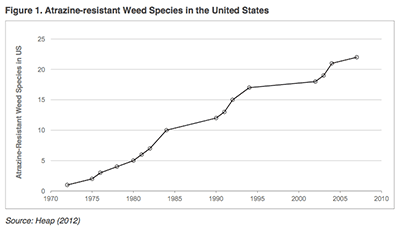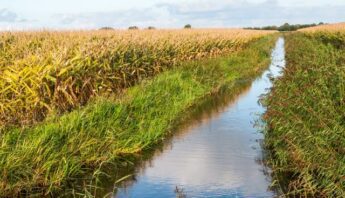The health harms of atrazine are no secret. A widely used herbicide — particularly on corn — it is a known endocrine disruptor that can cause birth defects and reproductive harm at very low levels. It's also a suspected carcinogen. Still, atrazine’s defenders, especially its manufacturer, Syngenta, return time and again to economics to rationalize the chemical's continued use.
Industry-funded studies claim that without atrazine, our agricultural economy would suffer devastating consequences. But a report released yesterday — Atrazine: Consider the Alternative — tells a different story. Taking a close look at the economics of atrazine, report authors conclude that Syngenta’s defense of the herbicide is full of holes.
Syngenta’s spin doctors
It comes as no surprise that Syngenta hand-picks its experts and put them on payroll to produce favorable data. That’s old news for scientific research, and the same is true for economics.
In November 2011, a group of Syngenta’s researchers released a series of five papers defending atrazine. Aptly named the “Atrazine Benefits Team,” these researchers hailed atrazine for doing everything from preventing soil erosion to contributing $3.3 billion to the agricultural economy.
But even if Syngenta hadn’t funded these papers, they contain enough flaws to be questionable on their own. Yesterday’s report shows that these studies significantly overestimate the benefits of atrazine.
No change in yields
While Syngenta insists that atrazine ensures high yields for corn growers, there are forceful examples to the contrary. Since Italy and Germany banned use of the herbicide in 1991, they have seen no significant decrease in crop yields. And USDA studies in 1994 and 1997 estimated that an atrazine ban would lead to a minimal yield decrease just over 1%.
The report Atrazine: Consider the Alternatives — commissioned by NRDC and conducted by environmental and agricultural economists Frank Ackerman, Melissa Whited and Patrick Knight —flags a major gap in Syngenta-funded research: the industry figures that cite drastically reduced yields, if atrazine use is halted, fail to take into account alternative agricultural practices that are less chemically intensive and can be highly effective.
 As farmers see increases in herbicide-resistant “superweeds” across the country, non-chemical farming practices are becoming more critical. And while Syngenta researchers are quick to point out the rise of glyphosate-resistant weeds as an argument in favor of atrazine use, they fail to acknowledge that atrazine-resistant weeds are also a quickly growing problem.
As farmers see increases in herbicide-resistant “superweeds” across the country, non-chemical farming practices are becoming more critical. And while Syngenta researchers are quick to point out the rise of glyphosate-resistant weeds as an argument in favor of atrazine use, they fail to acknowledge that atrazine-resistant weeds are also a quickly growing problem.
The report out yesterday touches on another important economic point: withdrawing atrazine from the market may actually increase revenue for growers. And the likely financial impact on consumers would be minimal; the cost of a hamburger would go up a little more than a penny, and a gallon of gas would increase about three cents.
Who wins?
The benefits of atrazine are elusive, but the costs are high. And clear. USDA found atrazine in 94% of the drinking water sampled, meaning exposure is widespread, and those who come in the most direct contact with the herbicide — farmers and farmworkers — face the greatest health risks. While Syngenta digs in their heels on their flagship product, more and more farmers are finding innovative, safe techniques to manage weeds without relying on atrazine.
The new report, Atrazine: Consider the Alternatives, ends with a strong reminder about who would benefit most from reduced reliance on the health-harming herbicide:
If U.S. agriculture moved away from atrazine, the winners would include farmworkers, farmers and their families, and others who are exposed to atrazine either directly from field uses or indirectly from contaminated tap water, along with the natural ecosystems that are currently damaged by atrazine. The winners would also include the nation’s corn growers.
What’s striking about this list of winners is that almost everyone is on it… with Syngenta the sole winner if atrazine stays in widespread use.
Independent economists have taken another rigorous look at atrazine, and found that it doesn’t measure up to its claims. It’s time for EPA to do the same.
Photo credit: TumblingRun/Flickr







